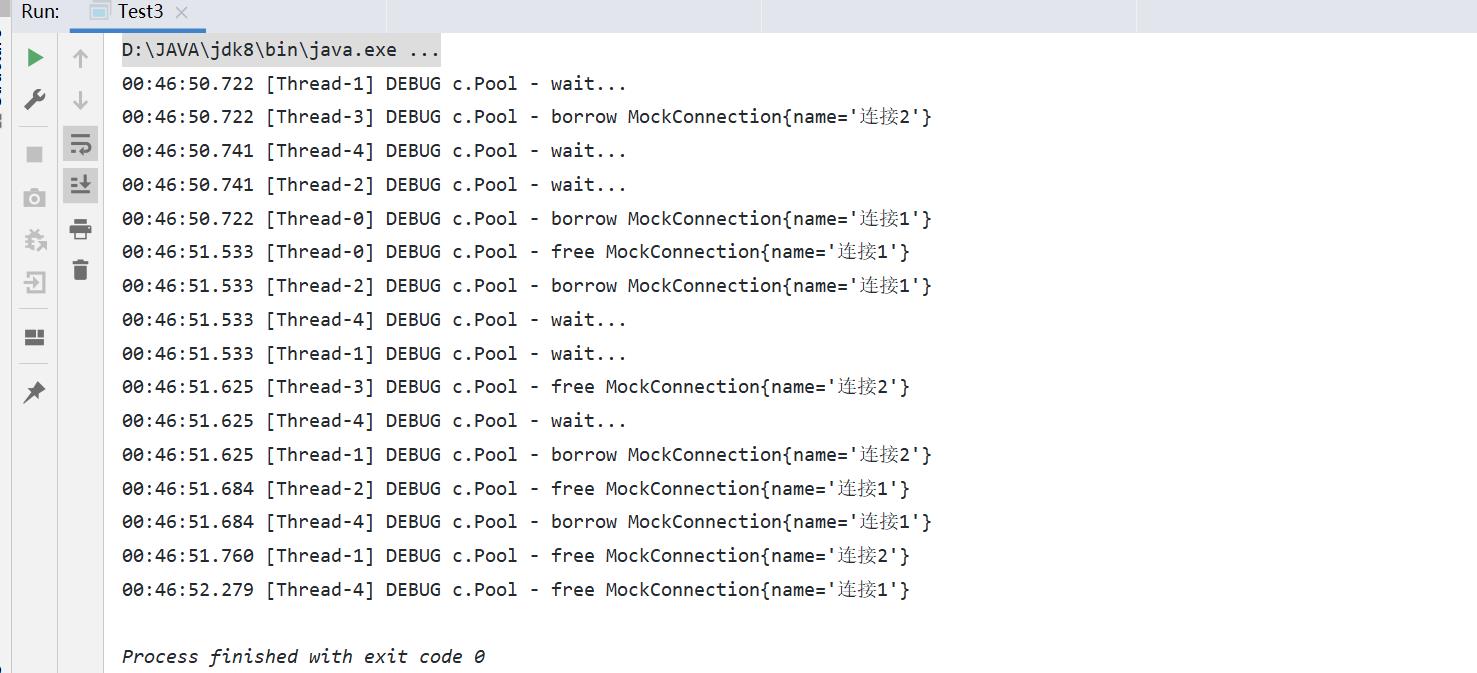JUC并发编程 -- 享元模式(定义和体现 & 自定义连接池)
Posted Z && Y
tags:
篇首语:本文由小常识网(cha138.com)小编为大家整理,主要介绍了JUC并发编程 -- 享元模式(定义和体现 & 自定义连接池)相关的知识,希望对你有一定的参考价值。
1. 定义和体现
1.1 定义
享元模式(Flyweight Pattern)主要用于减少创建对象的数量,以减少内存占用和提高性能。这种类型的设计模式属于结构型模式,它提供了减少对象数量从而改善应用所需的对象结构的方式。享元模式尝试重用现有的同类对象,如果未找到匹配的对象,则创建新对象。
1.2 体现
在JDK中 Boolean,Byte,Short,Integer,Long,Character 等包装类提供了 valueOf 方法,例如 Long 的valueOf 会缓存 -128~127 之间的 Long 对象,在这个范围之间会重用对象,大于这个范围,才会新建 Long 对
象:
public static Long valueOf(long l) {
final int offset = 128;
if (l >= -128 && l <= 127) {
// 从缓存中取数据
return LongCache.cache[(int)l + offset];
}
return new Long(l);
}
注意:
- Byte, Short, Long 缓存的范围都是 -128~127
- Character 缓存的范围是 0~127
- Integer的默认范围是 -128~127
- 最小值不能变
- 但最大值可以通过调整虚拟机参数
-Djava.lang.Integer.IntegerCache.high来改变
- Boolean 缓存了 TRUE 和 FALSE
2. 自定义连接池
2.1 引入
例如:一个线上商城应用,QPS 达到数千,如果每次都重新创建和关闭数据库连接,性能会受到极大影响。 这时预先创建好一批连接,放入连接池。一次请求到达后,从连接池获取连接,使用完毕后再还回连接池,这样既节约了连接的创建和关闭时间,也实现了连接的重用,不至于让庞大的连接数压垮数据库。
2.2 代码实现
package tian;
import lombok.extern.slf4j.Slf4j;
import java.sql.*;
import java.util.Map;
import java.util.Properties;
import java.util.Random;
import java.util.concurrent.Executor;
import java.util.concurrent.atomic.AtomicIntegerArray;
public class Test3 {
public static void main(String[] args) {
Pool pool = new Pool(2);
for (int i = 0; i < 5; i++) {
new Thread(() -> {
Connection conn = pool.borrow();
try {
Thread.sleep(new Random().nextInt(1000));
} catch (InterruptedException e) {
e.printStackTrace();
}
pool.free(conn);
}).start();
}
}
}
@Slf4j(topic = "c.Pool")
class Pool {
// 1. 连接池大小
private final int poolSize;
// 2. 连接对象数组
private Connection[] connections;
// 3. 连接状态数组 0 表示空闲, 1 表示繁忙
private AtomicIntegerArray states;
// 4. 构造方法初始化
public Pool(int poolSize) {
this.poolSize = poolSize;
this.connections = new Connection[poolSize];
this.states = new AtomicIntegerArray(new int[poolSize]);
for (int i = 0; i < poolSize; i++) {
connections[i] = new MockConnection("连接" + (i + 1));
}
}
// 5. 借连接
public Connection borrow() {
while (true) {
for (int i = 0; i < poolSize; i++) {
// 获取空闲连接
if (states.get(i) == 0) {
if (states.compareAndSet(i, 0, 1)) {
log.debug("borrow {}", connections[i]);
return connections[i];
}
}
}
// 因为CAS适合短时间运行的代码片段, 因为它会一直耗费CPU资源。
// 所以如果没有空闲连接,当前线程进入等待
synchronized (this) {
try {
log.debug("wait...");
this.wait();
} catch (InterruptedException e) {
e.printStackTrace();
}
}
}
}
// 6. 归还连接
public void free(Connection conn) {
for (int i = 0; i < poolSize; i++) {
if (connections[i] == conn) {
states.set(i, 0);
synchronized (this) {
// 如果有空闲连接 就通知其余正在等待的线程
log.debug("free {}", conn);
this.notifyAll();
}
break;
}
}
}
}
class MockConnection implements Connection {
private String name;
public MockConnection(String name) {
this.name = name;
}
@Override
public String toString() {
return "MockConnection{" +
"name='" + name + '\\'' +
'}';
}
@Override
public Statement createStatement() throws SQLException {
return null;
}
@Override
public PreparedStatement prepareStatement(String sql) throws SQLException {
return null;
}
@Override
public CallableStatement prepareCall(String sql) throws SQLException {
return null;
}
@Override
public String nativeSQL(String sql) throws SQLException {
return null;
}
@Override
public void setAutoCommit(boolean autoCommit) throws SQLException {
}
@Override
public boolean getAutoCommit() throws SQLException {
return false;
}
@Override
public void commit() throws SQLException {
}
@Override
public void rollback() throws SQLException {
}
@Override
public void close() throws SQLException {
}
@Override
public boolean isClosed() throws SQLException {
return false;
}
@Override
public DatabaseMetaData getMetaData() throws SQLException {
return null;
}
@Override
public void setReadOnly(boolean readOnly) throws SQLException {
}
@Override
public boolean isReadOnly() throws SQLException {
return false;
}
@Override
public void setCatalog(String catalog) throws SQLException {
}
@Override
public String getCatalog() throws SQLException {
return null;
}
@Override
public void setTransactionIsolation(int level) throws SQLException {
}
@Override
public int getTransactionIsolation() throws SQLException {
return 0;
}
@Override
public SQLWarning getWarnings() throws SQLException {
return null;
}
@Override
public void clearWarnings() throws SQLException {
}
@Override
public Statement createStatement(int resultSetType, int resultSetConcurrency) throws SQLException {
return null;
}
@Override
public PreparedStatement prepareStatement(String sql, int resultSetType, int resultSetConcurrency) throws SQLException {
return null;
}
@Override
public CallableStatement prepareCall(String sql, int resultSetType, int resultSetConcurrency) throws SQLException {
return null;
}
@Override
public Map<String, Class<?>> getTypeMap() throws SQLException {
return null;
}
@Override
public void setTypeMap(Map<String, Class<?>> map) throws SQLException {
}
@Override
public void setHoldability(int holdability) throws SQLException {
}
@Override
public int getHoldability() throws SQLException {
return 0;
}
@Override
public Savepoint setSavepoint() throws SQLException {
return null;
}
@Override
public Savepoint setSavepoint(String name) throws SQLException {
return null;
}
@Override
public void rollback(Savepoint savepoint) throws SQLException {
}
@Override
public void releaseSavepoint(Savepoint savepoint) throws SQLException {
}
@Override
public Statement createStatement(int resultSetType, int resultSetConcurrency, int resultSetHoldability) throws SQLException {
return null;
}
@Override
public PreparedStatement prepareStatement(String sql, int resultSetType, int resultSetConcurrency, int resultSetHoldability) throws SQLException {
return null;
}
@Override
public CallableStatement prepareCall(String sql, int resultSetType, int resultSetConcurrency, int resultSetHoldability) throws SQLException {
return null;
}
@Override
public PreparedStatement prepareStatement(String sql, int autoGeneratedKeys) throws SQLException {
return null;
}
@Override
public PreparedStatement prepareStatement(String sql, int[] columnIndexes) throws SQLException {
return null;
}
@Override
public PreparedStatement prepareStatement(String sql, String[] columnNames) throws SQLException {
return null;
}
@Override
public Clob createClob() throws SQLException {
return null;
}
@Override
public Blob createBlob() throws SQLException {
return null;
}
@Override
public NClob createNClob() throws SQLException {
return null;
}
@Override
public SQLXML createSQLXML() throws SQLException {
return null;
}
@Override
public boolean isValid(int timeout) throws SQLException {
return false;
}
@Override
public void setClientInfo(String name, String value) throws SQLClientInfoException {
}
@Override
public void setClientInfo(Properties properties) throws SQLClientInfoException {
}
@Override
public String getClientInfo(String name) throws SQLException {
return null;
}
@Override
public Properties getClientInfo() throws SQLException {
return null;
}
@Override
public Array createArrayOf(String typeName, Object[] elements) throws SQLException {
return null;
}
@Override
public Struct createStruct(String typeName, Object[] attributes) throws SQLException {
return null;
}
@Override
public void setSchema(String schema) throws SQLException {
}
@Override
public String getSchema() throws SQLException {
return null;
}
@Override
public void abort(Executor executor) throws SQLException {
}
@Override
public void setNetworkTimeout(Executor executor, int milliseconds) throws SQLException {
}
@Override
public int getNetworkTimeout() throws SQLException {
return 0;
}
@Override
public <T> T unwrap(Class<T> iface) throws SQLException {
return null;
}
@Override
public boolean isWrapperFor(Class<?> iface) throws SQLException {
return false;
}
}
2.3 运行结果

以上是关于JUC并发编程 -- 享元模式(定义和体现 & 自定义连接池)的主要内容,如果未能解决你的问题,请参考以下文章